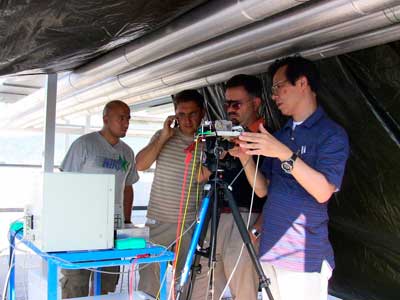Scientists Test World’s Fastest Wireless Network
Scientists in Pisa, Italy claim to have set a new world record for the fastest wireless data transmission. They report that during an uninterrupted 12-hour experiment, they were able to achieve throughput speeds above 1.2 Terabits per second; which they say beats the previous wireless data transmission speed record of 160 Gigabits per second by Korean scientists. The researchers claim that speeds of this magnitude can typically only be achieved using fiber optics.
The technology that the Pisa scientists utilized to achieve such high bandwidth, actually shares a significant similarity with fiber optics: Both technologies use optical communications. Unlike Wi-Fi or microwave communications, which use radio-based transmissions, the Pisa scientists used a Technology called free-space optical communications, which transmits data using light. The Harvard Broadband Communication Laboratory provides this explanation of Free-Space Optical Communications:
“Free space optical communications is a line-of-sight (LOS) technology that transmits a modulated beam of visible or infrared light through the atmosphere for broadband communications। In a manner similar to fiber optical communications, free space optics uses a light emitting diode (LED) or laser (light amplification by stimulated emission of radiation) point source for data transmission. However, in free space optics, an energy beam is collimated and transmitted through space rather than being guided through an optical cable. These beams of light, operating in the TeraHertz portion of the spectrum, are focused on a receiving lens connected to a high sensitivity receiver through an optical fiber.”

The Pisa researchers.
(Credit: Corriere Della Sera.it) |
Free space optical communications has often been considered as means for “inter-satellite communications” of spacecraft, as “it is possible to transmit tens of megabits per second or more over many thousands of kilometers, using moderate laser average powers of the order of a few watts” in the vacuum of space. On Earth, however, there are a number of challenges that currently limit the range of free space optical communications to only a few kilometers.
The Harvard Broadband Communication Laboratory states, “although relatively unaffected by rain and snow, free space optical communication systems can be severely affected by fog and atmospheric turbulence.” Fog is a problem because the size of water droplets in fog “can modify light characteristics or completely hinder the passage of light through a combination of absorption, scattering, and reflection.” One atmospheric problem is “scintillation,” which is essentially air pockets with different densities that act as lenses that impact the “temporal and spatial variation in light intensity.” Another atmospheric issue is “beam wander,” which is “when turbulent wind current (eddies) larger than the diameter of the transmitted optical beam cause a slow, but significant, displacement of the transmitted beam.”
One of the biggest challenges that free space optical communications faces–whether in space or on Earth–is that communications are limited to line-of-site. Unlike some radio communications, free space optical communications requires that no obstacles interfere with the beam, and it cannot bend around objects.
The Pisa team is made up of scientists from the Sant’Anna School of Advanced Studies of Pisa, Waseda University in Tokyo, and the National Institute of Information and Communications Technology in Tokyo. The team is led by Ernesto Ciaramella, who is an Associate Professor in Telecommunication at Sant’Anna. Ciaramella proposes that one way to get around a number of these limitations would be to develop a communications technology that uses a combination of “photonics and radio.” While Ciaramella did not elaborate on how such a scenario would be implemented, it is possible to envision a system where free space optical communications is used for back-end communications, and radio-based communications (such as Wi-Fi or WiMAX) are used for the last hundred feet or “last mile.”





